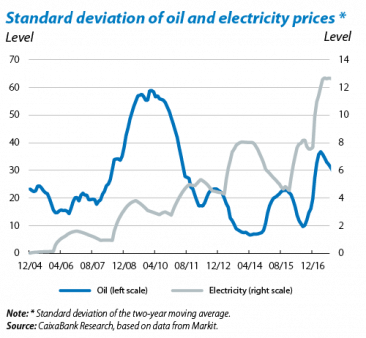The ups and downs of Spanish inflation: changing with energy
The underlying trend for Spanish inflation is stable, with very moderate rises. A good example of this is the evolution in core inflation, going from near-zero to around 1% in the past three years. Headline inflation has been much more volatile over the same period, however, going from negative rates to close to 3% before dropping again relatively sharply. While we expect the underlying trend to continue rising, headline inflation is very likely to remain erratic over the coming quarters.
As already mentioned, the underlying trend can clearly be seen by the evolution in core inflation. This is very likely to continue its gradual ascent. The euro’s appreciation in recent quarters, around 10% since the end of 2016, will certainly help to contain core inflation. Nevertheless the sustained and relatively high growth in economic activity and falling unemployment rate will continue to support a gradual recovery. We therefore expect core inflation to continue rising in 2018, reaching just over 1.5% towards the end of the year.
Headline inflation is expected to be around 1.7% next year. However, the CPI components not included in the core rate are more difficult to predict and will most likely continue to fluctuate considerably (see the enclosed chart). The trend in electricity prices is particularly significant. Although this accounts for a relatively small share of the CPI, specifically 3.5%, its fluctuations throughout the year have been so great they have ended up affecting headline inflation. In January 2017 the year-on-year increase was 26.2% while in October its growth rate fell to 3.4%. With due reservation, given the fluctuating electricity prices in Spain, and provided the upswing observed early last year is not repeated, the electricity component could fall by about 10% year-on-year in January 2018, which would push down headline inflation.
Fuel prices will also help to keep headline inflation volatile.1 The price of crude oil in euros has fluctuated widely in 2017, both due to the volatility of the euro-dollar exchange rate but particularly because of the volatility of crude oil prices in dollars. This has posted year-on-year growth rates that have altered by more than 20 pp from one month to the next. Although we expect the price of crude oil to stabilise at levels similar to the present, namely around EUR 52 per barrel of Brent quality, the year-on-year rate of change will fluctuate markedly (due to the volatility of crude prices in 2017), which will also affect headline inflation.
Increasing volatility in oil and electricity prices, especially since the recession beginning in 2008, has also increased the margin of error in the headline inflation forecast. Analysing the performance of both prices over the past few years we can state, with 40% probability, that in 2018 average inflation may deviate by around 0.5 pp regarding the forecast as a result of the behaviour of these two goods.2 Now, more than ever, we must focus on the evolution in core inflation to determine the underlying trend in prices.
1. Fuels account for 7.7% of the CPI, approximately twice as much as the euro area.
2. Specifically, for each variable, we have used the deviation corresponding to the 20th and 80th percentile of the empirical distribution for year-on-year changes.



